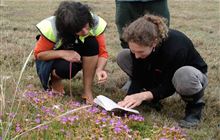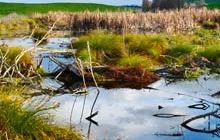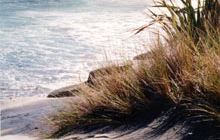About estuaries
Introduction
Estuaries are dynamic, rich ecosystems where freshwater mixes with the sea. Find out why they are important and some of the threats they face.Estuaries can also be called lagoons, harbours, inlets, sounds, river or stream mouths and wetlands. They are places where freshwater from the land, carried by streams and rivers, meets and mixes with saltwater from the ocean.
Tides exert a major influence on estuaries as salt water flows upstream and drains out twice each day. Waves, winds and storms shape estuaries, with some places protected from the full force of the ocean by reefs, islands, fingers of land, or areas of mud or sand.
Image gallery
-
Kohangatera Lake, Pencarrow, Wellington Image: | DOC
![Kohangatera Lake, Pencarrow, Wellington. Kohangatera Lake, Pencarrow, Wellington.]()
-
Manawatu Estuary Image: Don Ravine ©
![Manawatu Estuary. Manawatu Estuary.]()
-
Opouwae Estuary, Wairarapa coast Image: Wriggle Coastal Management ©
![Opouwae Estuary, Wairarapa coast. Opouwae Estuary, Wairarapa coast.]()
-
Avon-Heathcote Estuary, Canterbury Image: Helen Kettles | DOC
![Avon-Heathcote Estuary. Avon-Heathcote Estuary.]()
-
East Waituna Lagoon, Southland - an intermittently opening and closing coastal system Image: Phil Melgren | DOC
![East Waituna Lagoon, Southland. East Waituna Lagoon, Southland.]()
-
Greymouth River Estuary, West Coast Image: Helen Kettles | DOC
![Greymouth River Estuary, West Coast. Greymouth River Estuary, West Coast.]()
-
Inner Mahurangi Harbour, Rodney District Image: Helen Kettles | DOC
![Inner Mahurangi Harbour. Inner Mahurangi Harbour.]()
-
Moutere Inlet, Tasman Bay Image: Helen Kettles | DOC
![Moutere Inlet, Tasman Bay. Moutere Inlet, Tasman Bay.]()
-
Opouwae Estuary, Wairarapa coast Image: Wriggle Coastal Management ©
![Opouwae Estuary, Wairarapa coast. Opouwae Estuary, Wairarapa coast.]()
-
Otaki Estuary, Kapiti Coast Image: Helen Kettles | DOC
![Otaki Estuary, Kapiti Coast. Otaki Estuary, Kapiti Coast.]()
-
Torrent Bay Estuary, Abel Tasman National Park Image: Helen Kettles | DOC
![Torrent Bay Estuary, Abel Tasman National Park. Torrent Bay Estuary, Abel Tasman National Park.]()
-
Okete River, Raglan Harbour Image: Helen Kettles | DOC
![Okete River, Raglan Harbour. Okete River, Raglan Harbour.]()
-
Wairau River Estuary, Marlborough Image: Helen Kettles | DOC
![Wairau River Estuary, Marlborough. Wairau River Estuary, Marlborough.]()
Estuaries are important
Estuaries provide habitat and feeding grounds and for many fish, birds, shellfish, mammals and other wildlife. Many are threatened species.
For example the fernbird/matata, white heron/kōtuku and inanga. Migratory birds, such as godwit, use estuaries to rest and find food during their journeys.
Estuaries are fundamental to many of our coastal fisheries as they provide important habitat for spawning and allow juveniles to grow. For example research has shown that the Kaipara Harbour estuary is where 90% of the North Island west coast snapper start their life. Many native fish, including eels and whitebait, require freshwater and saltwater during their lifecycles.
Migratory birds use estuaries to rest and find food during their journeys. A large variety of native birds, including waders and ducks, also call these places home.
Estuaries maintain water quality in the sea by filtering out sediment and nutrients. Microorganisms break down organic matter and sediments bind pollutants.
Threats to estuaries
Plants and animals living in estuaries have adapted to the dynamic environment but the pressures from land and sea are increasing.
Many of New Zealand's estuary edges have been filled in or drained for farms, factories or housing. Unless estuaries have space around them, as the sea level rises due to climate change, estuaries will also be squeezed into smaller areas and we will lose valuable habitats.
Activities in the surrounding catchments, such as land clearing for urban development and farming, have increased sedimentation. These activities expose the soil to rain and increase the amount of water and sediment going into rivers and streams.
Other changes in land use have also resulted in higher nutrient levels in some of our waterways. The extra sediment and nutrients end up in our estuaries and coasts. This can smother plants and animals living in estuaries. Extra sediment and nutrients make the water murky. This can be a problem for plants that need a lot of light such as seagrass, and for animals that need to 'breathe' the water. Extra nutrients can also cause algal blooms.
Weeds such as cordgrass are also smothering native plants and animals in some estuaries.
Estuaries are champions for our biggest global challenge - climate change. Habitats such as mangroves, saltmarsh and seagrass capture carbon 4- 10 times more carbon that forests so are a great option for us to reach our Zero Carbon target. In addition, these habitats protect our coastlines and infrastructure from storm surge which is becoming more of an issue due to sealevel rise.
Our work
DOC has an important national role with estuaries as the largest manager of estuarine reserve areas. We also provide leadership with the New Zealand Coastal Policy Statement – the overarching document councils follow for coastal management. Effective planning processes are important to reduce the impact of construction, urban development and farming on estuaries and other coastal habitats.
We recognise the strong connection Māori have with freshwater and estuaries which are an integral to the concept of ki uta ki tai (from the mountains to the sea). Iwi and hapū are strong partners in the management of healthy estuaries and catchments all around the country. They bring knowledge to the table from generations of observation of the environmental change in their estuaries. This knowledge includes monitoring of resources, such as kaimoana, and from decisions about conservation measures such as rāhui.
DOC is working alongside councils (the main estuary management agencies), many iwi/hapū and whānau, community groups and individuals to protect and restore our estuaries. Some are planting along river banks to help reduce the sediment going into our waterways. Other groups are checking the health of their local streams, monitoring the health of cockles and restoring seagrass beds. There are numerous catchment wide processes around New Zealand where groups are working together to make a difference.
Monitoring estuaries
Much of the monitoring is related to detecting four key stresses and pressures: sedimentation, high nutrients, chemical contamination and habitat loss.
Many estuaries are monitored to identify whether the estuary is safe for recreational activities and the gathering of fish/shellfish.
Microbiological contamination is also monitored in many estuaries to identify whether the estuary is safe for recreational activities and the gathering of fish/shellfish.
View a map showing where estuaries are being monitored.
Restoring estuaries
Many of New Zealand's estuaries have been degraded through intensive land-use practices, land reclamation, pollution and alterations to natural flow and tidal regimes.
Restoration work throughout New Zealand is helping to restore estuaries to a healthy condition. Much restoration work is driven by iwi and local community groups concerned with the decline in the state of a local estuary, whether it is a decline in whitebait, birds or cockle abundance.
Estuarine restoration groups focus in two areas:
- groups working within the estuary and its margins
- groups working in the catchments of the rivers and streams that flow into the estuary.
Both approaches are vital for restoring the ecology of estuaries.
View a map of where estuary restoration is happening.
Experiencing estuaries
There many educational resources, trails and walkways for estuaries around New Zealand.
View a map of places to experience and learn about estuaries.
















